Abstract
To clarify the physiological roles of CD36 as an oxidized low density lipoprotein (OxLDL) receptor, we analyzed the monocyte-derived macrophages from normal and two CD36-deficient subjects, since we identified the molecular abnormalities (Kashiwagi, H., Y. Tomiyama, Y. Kosugi, M. Shiraga, R. H. Lipsky, Y. Kanayama, Y. Kurata, and Y. Matsuzawa 1994. Blood. 83:3545-3552; and Kashiwagi, H., Y. Tomiyama, S. Honda, S. Kosugi, M. Shiraga, N. Nagao, S. Sekiguchi, Y. Kanayama, Y. Kurata, and Y. Matsuzawa. 1995. J. Clin. Invest. 95:1040-1046). Scatchard analysis of 125I-OxLDL binding showed a linear plot and the maximum binding was lower by approximately 40% in the macrophages from subjects with CD36 deficiency than those from normal controls. Competition studies showed that the uptake of 125I-OxLDL was suppressed by OKM5, an antibody against CD36, by 53% in normal control macrophages, but not in the CD36-deficient macrophages. After incubation with OxLDL for 24 h, cholesteryl ester mass accumulation was reduced by approximately 40% in the macrophages from CD36-deficient subjects than those from normal controls. These results suggest that CD36 is one of the physiological receptors for OxLDL. Since specific binding of OxLDL was only reduced by approximately 40% in spite of the complete deficiency of CD36, several other receptors also may have some role in OxLDL uptake. Further studies will be needed to assess the quantitative role of CD36 in foam cell formation in vivo.
Full text
PDF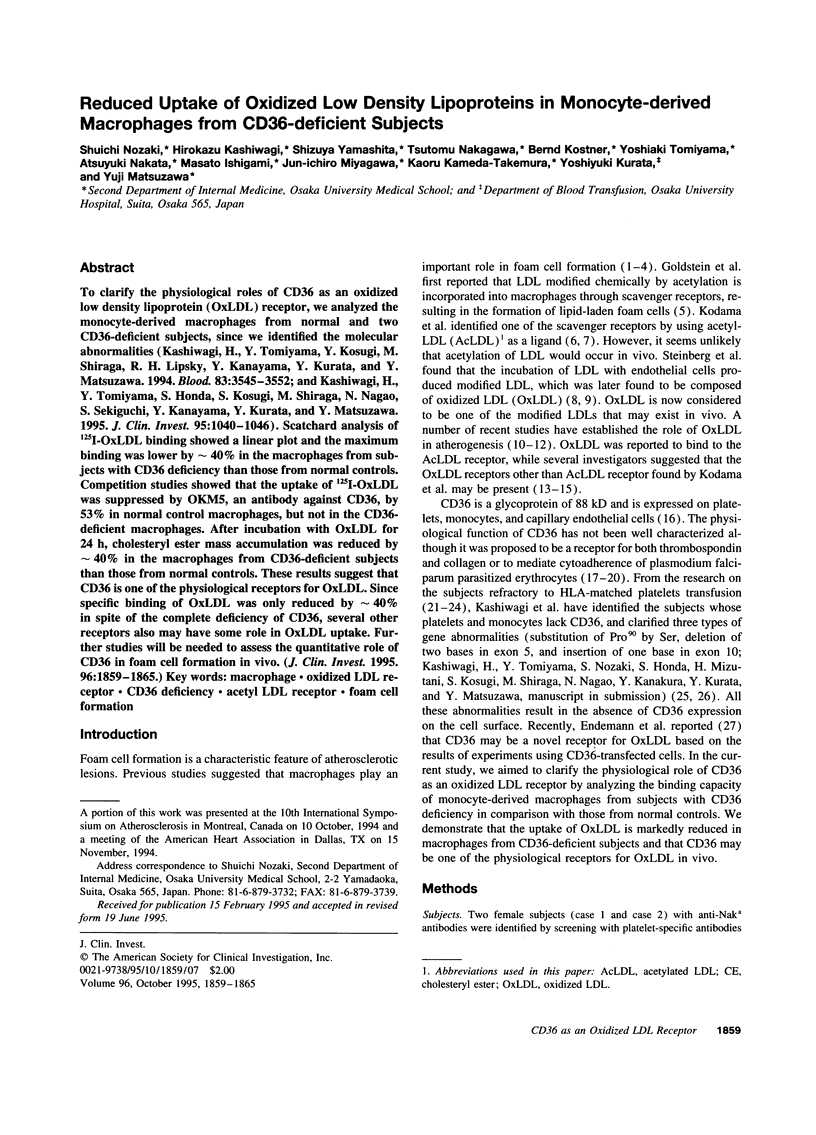
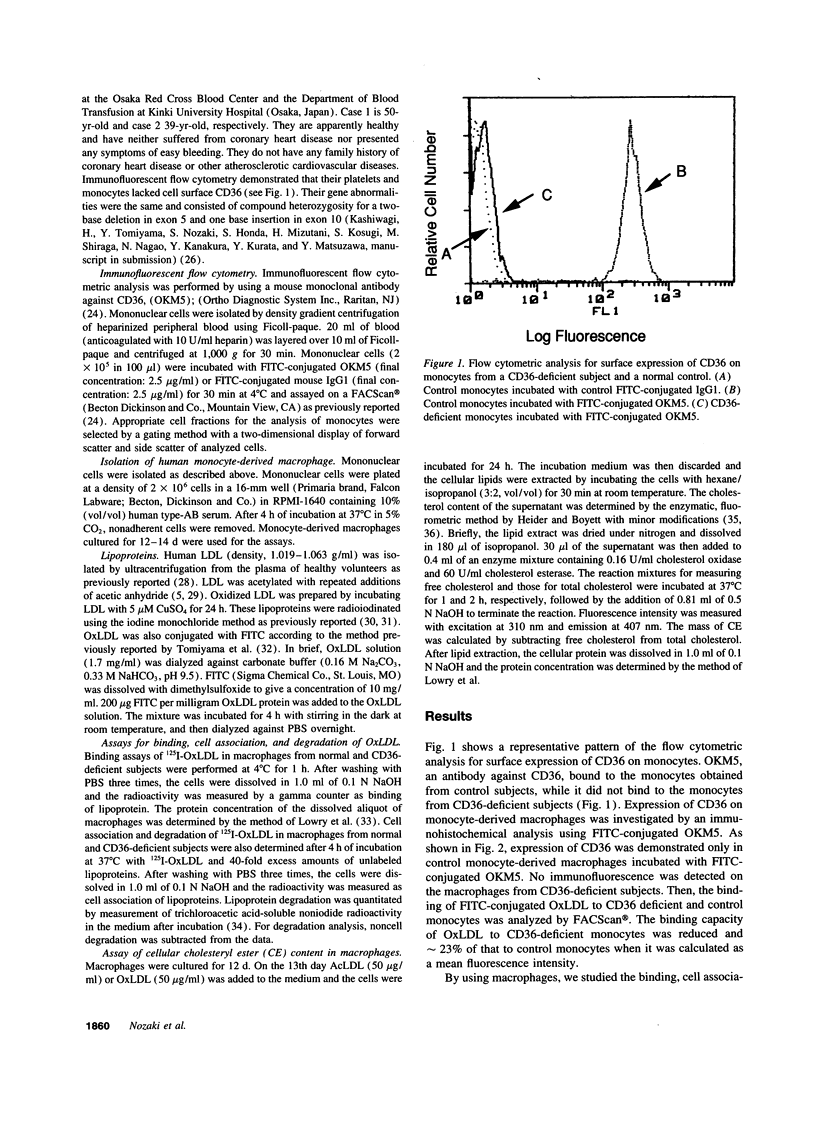
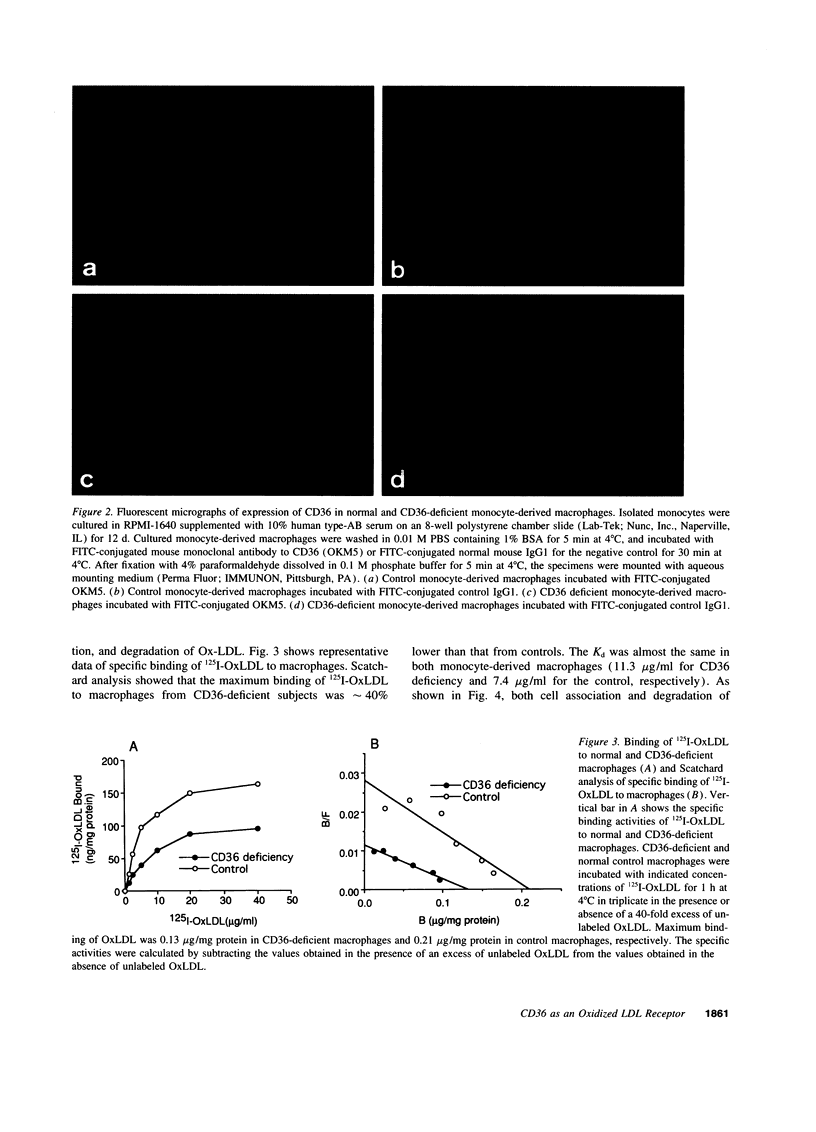
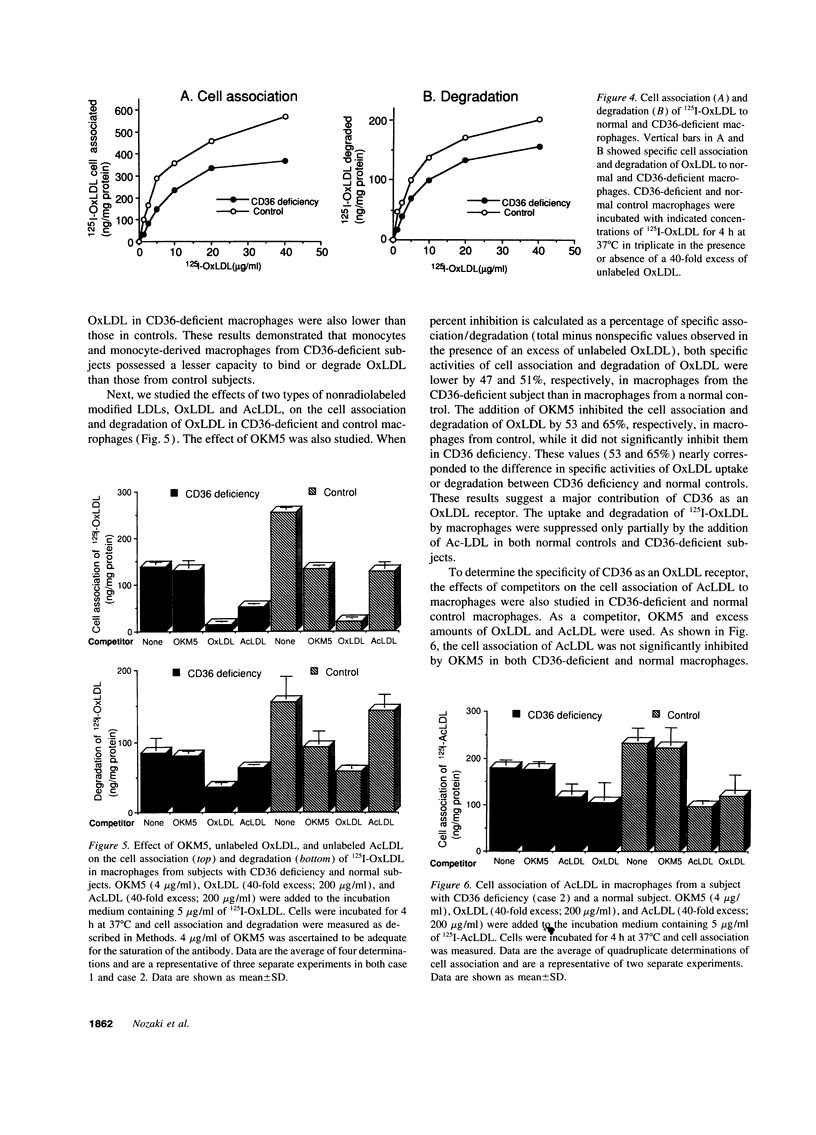
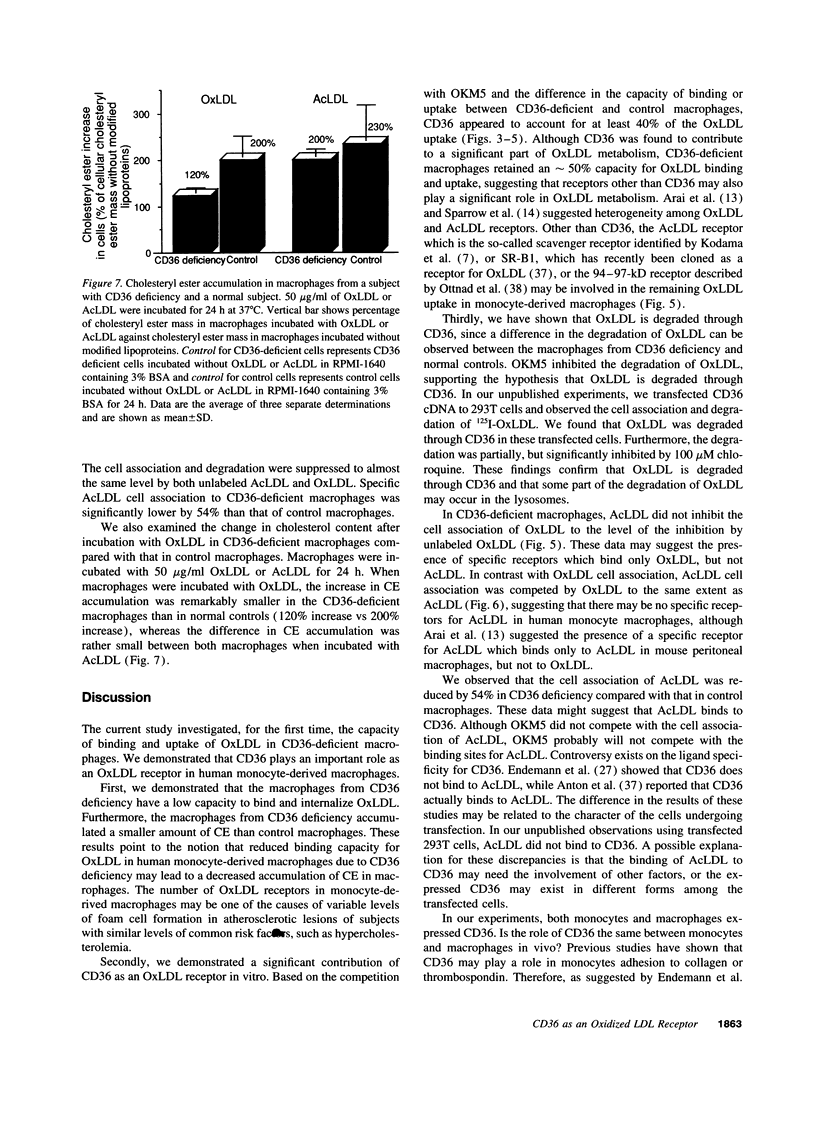
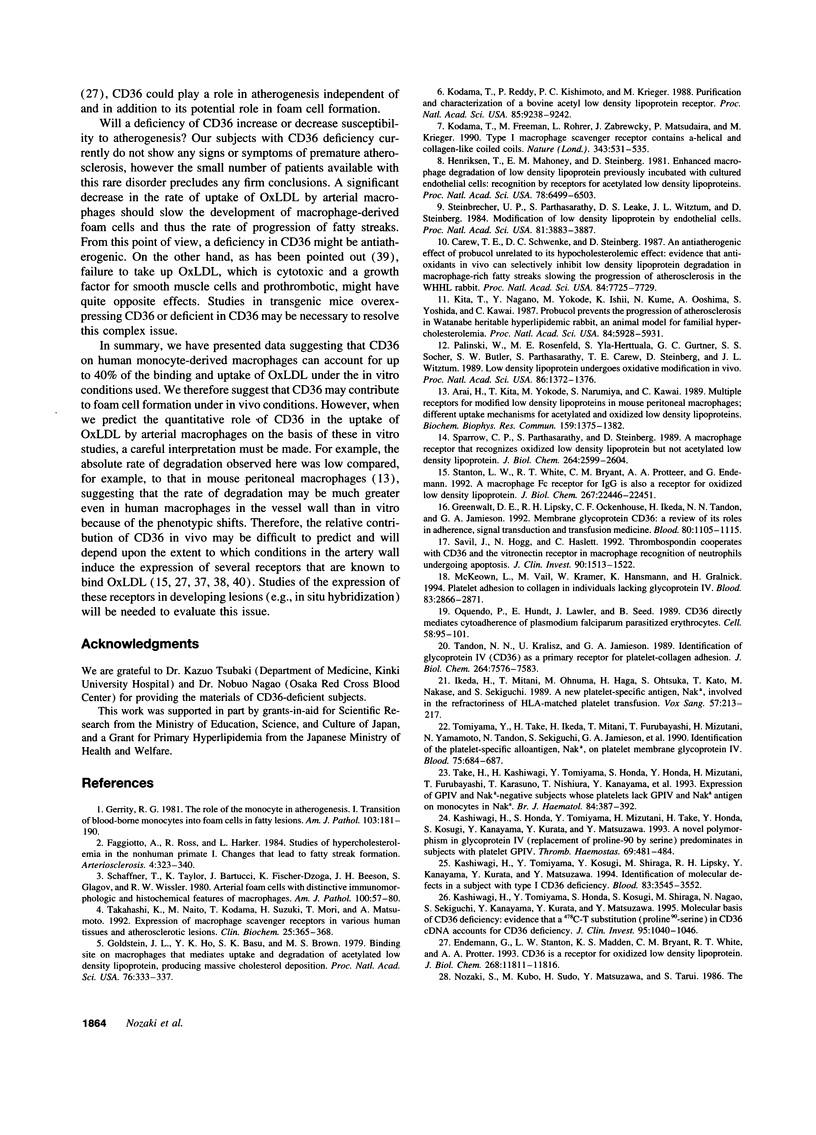
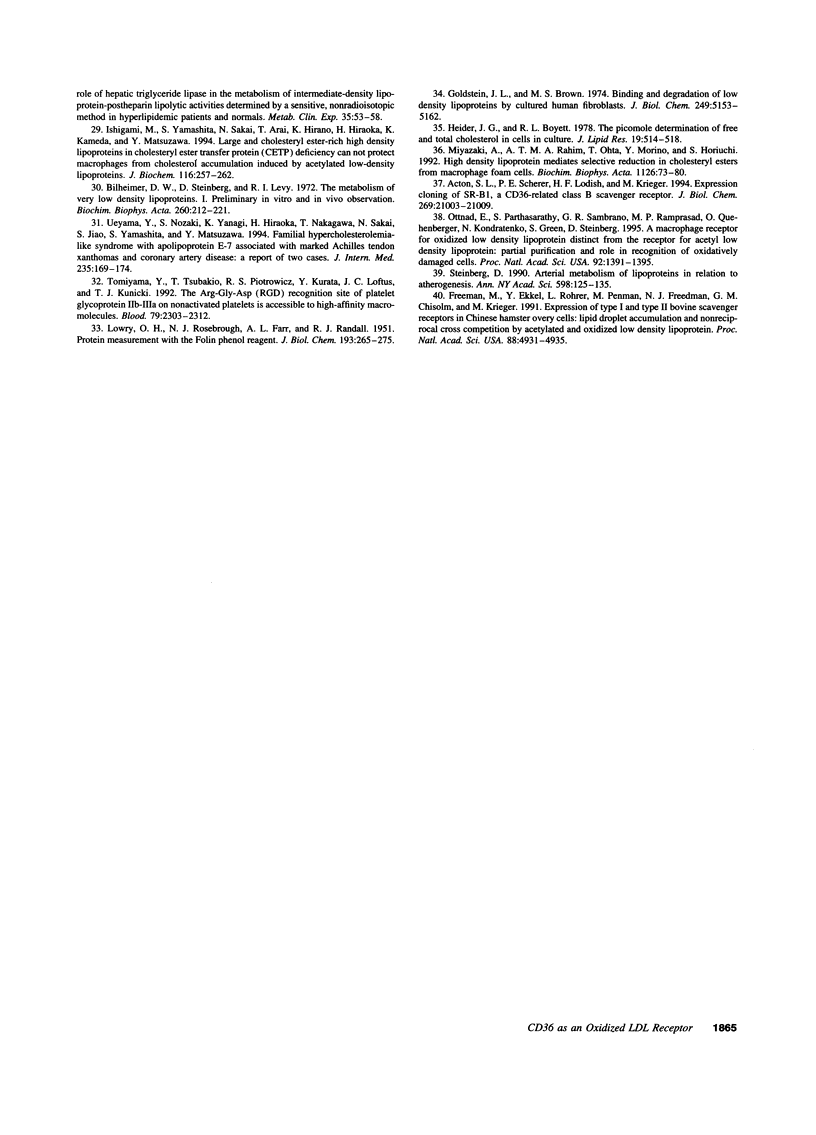
Images in this article
Selected References
These references are in PubMed. This may not be the complete list of references from this article.
- Acton S. L., Scherer P. E., Lodish H. F., Krieger M. Expression cloning of SR-BI, a CD36-related class B scavenger receptor. J Biol Chem. 1994 Aug 19;269(33):21003–21009. [PubMed] [Google Scholar]
- Arai H., Kita T., Yokode M., Narumiya S., Kawai C. Multiple receptors for modified low density lipoproteins in mouse peritoneal macrophages: different uptake mechanisms for acetylated and oxidized low density lipoproteins. Biochem Biophys Res Commun. 1989 Mar 31;159(3):1375–1382. doi: 10.1016/0006-291x(89)92262-6. [DOI] [PubMed] [Google Scholar]
- Bilheimer D. W., Eisenberg S., Levy R. I. The metabolism of very low density lipoprotein proteins. I. Preliminary in vitro and in vivo observations. Biochim Biophys Acta. 1972 Feb 21;260(2):212–221. doi: 10.1016/0005-2760(72)90034-3. [DOI] [PubMed] [Google Scholar]
- Carew T. E., Schwenke D. C., Steinberg D. Antiatherogenic effect of probucol unrelated to its hypocholesterolemic effect: evidence that antioxidants in vivo can selectively inhibit low density lipoprotein degradation in macrophage-rich fatty streaks and slow the progression of atherosclerosis in the Watanabe heritable hyperlipidemic rabbit. Proc Natl Acad Sci U S A. 1987 Nov;84(21):7725–7729. doi: 10.1073/pnas.84.21.7725. [DOI] [PMC free article] [PubMed] [Google Scholar]
- Endemann G., Stanton L. W., Madden K. S., Bryant C. M., White R. T., Protter A. A. CD36 is a receptor for oxidized low density lipoprotein. J Biol Chem. 1993 Jun 5;268(16):11811–11816. [PubMed] [Google Scholar]
- Faggiotto A., Ross R., Harker L. Studies of hypercholesterolemia in the nonhuman primate. I. Changes that lead to fatty streak formation. Arteriosclerosis. 1984 Jul-Aug;4(4):323–340. doi: 10.1161/01.atv.4.4.323. [DOI] [PubMed] [Google Scholar]
- Freeman M., Ekkel Y., Rohrer L., Penman M., Freedman N. J., Chisolm G. M., Krieger M. Expression of type I and type II bovine scavenger receptors in Chinese hamster ovary cells: lipid droplet accumulation and nonreciprocal cross competition by acetylated and oxidized low density lipoprotein. Proc Natl Acad Sci U S A. 1991 Jun 1;88(11):4931–4935. doi: 10.1073/pnas.88.11.4931. [DOI] [PMC free article] [PubMed] [Google Scholar]
- Gerrity R. G. The role of the monocyte in atherogenesis: I. Transition of blood-borne monocytes into foam cells in fatty lesions. Am J Pathol. 1981 May;103(2):181–190. [PMC free article] [PubMed] [Google Scholar]
- Goldstein J. L., Brown M. S. Binding and degradation of low density lipoproteins by cultured human fibroblasts. Comparison of cells from a normal subject and from a patient with homozygous familial hypercholesterolemia. J Biol Chem. 1974 Aug 25;249(16):5153–5162. [PubMed] [Google Scholar]
- Goldstein J. L., Ho Y. K., Basu S. K., Brown M. S. Binding site on macrophages that mediates uptake and degradation of acetylated low density lipoprotein, producing massive cholesterol deposition. Proc Natl Acad Sci U S A. 1979 Jan;76(1):333–337. doi: 10.1073/pnas.76.1.333. [DOI] [PMC free article] [PubMed] [Google Scholar]
- Greenwalt D. E., Lipsky R. H., Ockenhouse C. F., Ikeda H., Tandon N. N., Jamieson G. A. Membrane glycoprotein CD36: a review of its roles in adherence, signal transduction, and transfusion medicine. Blood. 1992 Sep 1;80(5):1105–1115. [PubMed] [Google Scholar]
- Heider J. G., Boyett R. L. The picomole determination of free and total cholesterol in cells in culture. J Lipid Res. 1978 May;19(4):514–518. [PubMed] [Google Scholar]
- Henriksen T., Mahoney E. M., Steinberg D. Enhanced macrophage degradation of low density lipoprotein previously incubated with cultured endothelial cells: recognition by receptors for acetylated low density lipoproteins. Proc Natl Acad Sci U S A. 1981 Oct;78(10):6499–6503. doi: 10.1073/pnas.78.10.6499. [DOI] [PMC free article] [PubMed] [Google Scholar]
- Ikeda H., Mitani T., Ohnuma M., Haga H., Ohtzuka S., Kato T., Nakase T., Sekiguchi S. A new platelet-specific antigen, Naka, involved in the refractoriness of HLA-matched platelet transfusion. Vox Sang. 1989;57(3):213–217. doi: 10.1111/j.1423-0410.1989.tb00826.x. [DOI] [PubMed] [Google Scholar]
- Ishigami M., Yamashita S., Sakai N., Arai T., Hirano K., Hiraoka H., Kameda-Takemura K., Matsuzawa Y. Large and cholesteryl ester-rich high-density lipoproteins in cholesteryl ester transfer protein (CETP) deficiency can not protect macrophages from cholesterol accumulation induced by acetylated low-density lipoproteins. J Biochem. 1994 Aug;116(2):257–262. doi: 10.1093/oxfordjournals.jbchem.a124516. [DOI] [PubMed] [Google Scholar]
- Kashiwagi H., Honda S., Tomiyama Y., Mizutani H., Take H., Honda Y., Kosugi S., Kanayama Y., Kurata Y., Matsuzawa Y. A novel polymorphism in glycoprotein IV (replacement of proline-90 by serine) predominates in subjects with platelet GPIV deficiency. Thromb Haemost. 1993 May 3;69(5):481–484. [PubMed] [Google Scholar]
- Kashiwagi H., Tomiyama Y., Honda S., Kosugi S., Shiraga M., Nagao N., Sekiguchi S., Kanayama Y., Kurata Y., Matsuzawa Y. Molecular basis of CD36 deficiency. Evidence that a 478C-->T substitution (proline90-->serine) in CD36 cDNA accounts for CD36 deficiency. J Clin Invest. 1995 Mar;95(3):1040–1046. doi: 10.1172/JCI117749. [DOI] [PMC free article] [PubMed] [Google Scholar]
- Kashiwagi H., Tomiyama Y., Kosugi S., Shiraga M., Lipsky R. H., Kanayama Y., Kurata Y., Matsuzawa Y. Identification of molecular defects in a subject with type I CD36 deficiency. Blood. 1994 Jun 15;83(12):3545–3552. [PubMed] [Google Scholar]
- Kita T., Nagano Y., Yokode M., Ishii K., Kume N., Ooshima A., Yoshida H., Kawai C. Probucol prevents the progression of atherosclerosis in Watanabe heritable hyperlipidemic rabbit, an animal model for familial hypercholesterolemia. Proc Natl Acad Sci U S A. 1987 Aug;84(16):5928–5931. doi: 10.1073/pnas.84.16.5928. [DOI] [PMC free article] [PubMed] [Google Scholar]
- Kodama T., Freeman M., Rohrer L., Zabrecky J., Matsudaira P., Krieger M. Type I macrophage scavenger receptor contains alpha-helical and collagen-like coiled coils. Nature. 1990 Feb 8;343(6258):531–535. doi: 10.1038/343531a0. [DOI] [PubMed] [Google Scholar]
- Kodama T., Reddy P., Kishimoto C., Krieger M. Purification and characterization of a bovine acetyl low density lipoprotein receptor. Proc Natl Acad Sci U S A. 1988 Dec;85(23):9238–9242. doi: 10.1073/pnas.85.23.9238. [DOI] [PMC free article] [PubMed] [Google Scholar]
- LOWRY O. H., ROSEBROUGH N. J., FARR A. L., RANDALL R. J. Protein measurement with the Folin phenol reagent. J Biol Chem. 1951 Nov;193(1):265–275. [PubMed] [Google Scholar]
- McKeown L., Vail M., Williams S., Kramer W., Hansmann K., Gralnick H. Platelet adhesion to collagen in individuals lacking glycoprotein IV. Blood. 1994 May 15;83(10):2866–2871. [PubMed] [Google Scholar]
- Miyazaki A., Rahim A. T., Ohta T., Morino Y., Horiuchi S. High density lipoprotein mediates selective reduction in cholesteryl esters from macrophage foam cells. Biochim Biophys Acta. 1992 Jun 5;1126(1):73–80. doi: 10.1016/0005-2760(92)90219-l. [DOI] [PubMed] [Google Scholar]
- Nozaki S., Kubo M., Sudo H., Matsuzawa Y., Tarui S. The role of hepatic triglyceride lipase in the metabolism of intermediate-density lipoprotein--postheparin lipolytic activities determined by a sensitive, nonradioisotopic method in hyperlipidemic patients and normals. Metabolism. 1986 Jan;35(1):53–58. doi: 10.1016/0026-0495(86)90095-8. [DOI] [PubMed] [Google Scholar]
- Oquendo P., Hundt E., Lawler J., Seed B. CD36 directly mediates cytoadherence of Plasmodium falciparum parasitized erythrocytes. Cell. 1989 Jul 14;58(1):95–101. doi: 10.1016/0092-8674(89)90406-6. [DOI] [PubMed] [Google Scholar]
- Ottnad E., Parthasarathy S., Sambrano G. R., Ramprasad M. P., Quehenberger O., Kondratenko N., Green S., Steinberg D. A macrophage receptor for oxidized low density lipoprotein distinct from the receptor for acetyl low density lipoprotein: partial purification and role in recognition of oxidatively damaged cells. Proc Natl Acad Sci U S A. 1995 Feb 28;92(5):1391–1395. doi: 10.1073/pnas.92.5.1391. [DOI] [PMC free article] [PubMed] [Google Scholar]
- Palinski W., Rosenfeld M. E., Ylä-Herttuala S., Gurtner G. C., Socher S. S., Butler S. W., Parthasarathy S., Carew T. E., Steinberg D., Witztum J. L. Low density lipoprotein undergoes oxidative modification in vivo. Proc Natl Acad Sci U S A. 1989 Feb;86(4):1372–1376. doi: 10.1073/pnas.86.4.1372. [DOI] [PMC free article] [PubMed] [Google Scholar]
- Savill J., Hogg N., Ren Y., Haslett C. Thrombospondin cooperates with CD36 and the vitronectin receptor in macrophage recognition of neutrophils undergoing apoptosis. J Clin Invest. 1992 Oct;90(4):1513–1522. doi: 10.1172/JCI116019. [DOI] [PMC free article] [PubMed] [Google Scholar]
- Schaffner T., Taylor K., Bartucci E. J., Fischer-Dzoga K., Beeson J. H., Glagov S., Wissler R. W. Arterial foam cells with distinctive immunomorphologic and histochemical features of macrophages. Am J Pathol. 1980 Jul;100(1):57–80. [PMC free article] [PubMed] [Google Scholar]
- Sparrow C. P., Parthasarathy S., Steinberg D. A macrophage receptor that recognizes oxidized low density lipoprotein but not acetylated low density lipoprotein. J Biol Chem. 1989 Feb 15;264(5):2599–2604. [PubMed] [Google Scholar]
- Stanton L. W., White R. T., Bryant C. M., Protter A. A., Endemann G. A macrophage Fc receptor for IgG is also a receptor for oxidized low density lipoprotein. J Biol Chem. 1992 Nov 5;267(31):22446–22451. [PubMed] [Google Scholar]
- Steinberg D. Arterial metabolism of lipoproteins in relation to atherogenesis. Ann N Y Acad Sci. 1990;598:125–135. doi: 10.1111/j.1749-6632.1990.tb42284.x. [DOI] [PubMed] [Google Scholar]
- Steinbrecher U. P., Parthasarathy S., Leake D. S., Witztum J. L., Steinberg D. Modification of low density lipoprotein by endothelial cells involves lipid peroxidation and degradation of low density lipoprotein phospholipids. Proc Natl Acad Sci U S A. 1984 Jun;81(12):3883–3887. doi: 10.1073/pnas.81.12.3883. [DOI] [PMC free article] [PubMed] [Google Scholar]
- Takahashi K., Naito M., Kodama T., Suzuki H., Mori T., Matsumoto A. Expression of macrophage scavenger receptors in various human tissues and atherosclerotic lesions. Clin Biochem. 1992 Oct;25(5):365–368. doi: 10.1016/0009-9120(92)80018-c. [DOI] [PubMed] [Google Scholar]
- Take H., Kashiwagi H., Tomiyama Y., Honda S., Honda Y., Mizutani H., Furubayashi T., Karasuno T., Nishiura T., Kanayama Y. Expression of GPIV and N(aka) antigen on monocytes in N(aka)-negative subjects whose platelets lack GPIV. Br J Haematol. 1993 Jul;84(3):387–391. doi: 10.1111/j.1365-2141.1993.tb03091.x. [DOI] [PubMed] [Google Scholar]
- Tandon N. N., Kralisz U., Jamieson G. A. Identification of glycoprotein IV (CD36) as a primary receptor for platelet-collagen adhesion. J Biol Chem. 1989 May 5;264(13):7576–7583. [PubMed] [Google Scholar]
- Tomiyama Y., Take H., Ikeda H., Mitani T., Furubayashi T., Mizutani H., Yamamoto N., Tandon N. N., Sekiguchi S., Jamieson G. A. Identification of the platelet-specific alloantigen, Naka, on platelet membrane glycoprotein IV. Blood. 1990 Feb 1;75(3):684–687. [PubMed] [Google Scholar]
- Tomiyama Y., Tsubakio T., Piotrowicz R. S., Kurata Y., Loftus J. C., Kunicki T. J. The Arg-Gly-Asp (RGD) recognition site of platelet glycoprotein IIb-IIIa on nonactivated platelets is accessible to high-affinity macromolecules. Blood. 1992 May 1;79(9):2303–2312. [PubMed] [Google Scholar]
- Ueyama Y., Nozaki S., Yanagi K., Hiraoka H., Nakagawa T., Sakai N., Jiao S., Yamashita S., Matsuzawa Y. Familial hypercholesterolaemia-like syndrome with apolipoprotein E-7 associated with marked Achilles tendon xanthomas and coronary artery disease: a report of two cases. J Intern Med. 1994 Feb;235(2):169–174. doi: 10.1111/j.1365-2796.1994.tb01051.x. [DOI] [PubMed] [Google Scholar]






